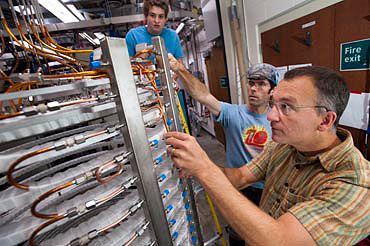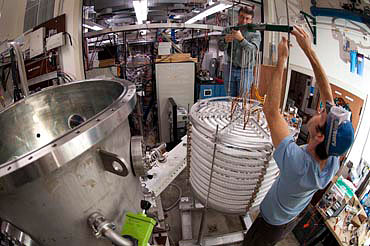Scientists hope to mimic nature’s dynamos
In the cosmos, all celestial objects — planets, stars, galaxies and clusters of galaxies — have magnetic fields. On Earth, the magnetic field of our home planet is most easily observed in a compass where the needle points north.

On Oct. 2, 2009, physics professor Cary Forest (right) discusses with instrumentation specialist Mike Clark (center wearing hat) and undergraduate Jonathan Jara-Almonte the team’s plan for custom-making the remaining coolant connections for a plasma couette experiment in Chamberlin Hall. The equipment uses an array of opposing magnets and electrodes to test the properties of plasma gas and magnetic fields within a vacuum vessel. The experiment is a precursor to a Plasma Dynamo Facility to be built in Sterling Hall within the next three years, using $2.4 million in stimulus funding from the National Science Foundation (NSF). The facility will be co-led by Forest and astronomy professor Ellen Zweibel.
Photo: Jeff Miller
But the origin of magnetic fields in the universe — including Earth’s — remains a puzzle of cosmology despite many determined efforts by scientists to ferret out the secrets of how they first arose. Now, with the help of $2.4 million in stimulus funding from the National Science Foundation, UW–Madison scientists will attempt to generate a magnetic field in precisely the same fashion as a planet or galaxy: by building and operating a plasma dynamo to explore the self-generation of magnetic fields.
“We don’t know why there are magnetic fields in the universe,” says UW–Madison professor of astronomy Ellen Zweibel, who, along with UW–Madison physics professor Cary Forest, will lead the new initiative. “They didn’t come out in the Big Bang. We don’t know how they originated or are sustained.”
The crucible for the study of cosmic magnetic fields will be the Plasma Dynamo Facility in Sterling Hall, the heart of which will be a three-meter diameter spherical stainless steel vessel that will contain the same kind of plasmas observed in space. Plasmas, sometimes referred to as the fourth state of matter, are superheated gases where the atoms that make up the gas have been stripped of all of their electrons leaving behind a conducting, highly electrified collection of atomic nuclei and free electrons.
The sun, for example, is a plasma and, ironically, were it not for the Earth’s magnetic field, the solar winds generated by the sun would scorch our planet. The atmosphere of Mars, some scientists think, was blasted away by solar wind when its dynamo stopped.

Mike Clark (right) and instrumentation innovator John Wallace (left) prepare to lift an array of opposing magnets and electrodes into the vacuum vessel (far left).
Photo: Jeff Miller
Zweibel notes that there are important distinctions between planetary dynamos, which are generated typically in the molten metal at the core of a planet, and the dynamos in stars and galaxies, which are powered by plasmas. Both, however, generate critical magnetic fields, and what sparked the different types of dynamos is unknown in both instances.
“This plasma dynamo experiment will allow us to study for the first time in the laboratory how plasma can put energy into a magnetic field instead of taking energy out,” adds Forest, an expert on nature’s dynamos who has built similar devices that use molten metal instead of plasma to spontaneously generate magnetic fields. Now, the only way scientists can study astrophysical plasmas is by observing and taking spectra from stars and other objects, and through the occasional direct sampling of a plasma by spacecraft designed to scoop up particles in space.
The plasma dynamo facility will be the first of its kind in the world and promises to take the quest for the secrets of the magnetic fields in the universe to another level: “The ability to pull out features in plasmas that are not present in the simpler liquid metal systems is the key,” says Zweibel, an expert in plasma astrophysics.
The new Plasma Dynamo Facility, to be constructed over three years, will significantly involve UW–Madison graduate and undergraduate students, say Forest and Zweibel, and the infusion of stimulus money will help prevent the layoff of at least one engineer at UW–Madison.




